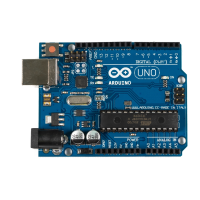Creating Games and Game Controllers with the Arduino
If you’re thinking about a proper case for the game controller you’ve built in the pre-
ceding chapter, you might have a look at the Lego/Arduino controller.
a
Its innards
differ from the controller we’ve built, but its case is really cool.
You can use the Arduino to build more than your own cool game controllers. You can
also use it to build some cool games. With the right extension shields, you can even
turn an Arduino into a powerful gaming console. The most powerful extension shields
are probably the Gameduino
b
and its successor, Gameduino 2.
c
If you don’t need color graphics and stereo sound, you can find even cheaper solutions,
such as the Video Game Shield
d
or the Hackvision.
e
They generate a monochrome
video signal, and you can learn how to do it yourself in Chapter 8, Generating Video
Signals with an Arduino, on page 127.
While looking for a solution that doesn’t need an external monitor, someone built a
Super Mario Bros. clone with minimal hardware requirements.
f
It’s a perfect example
of the unbelievable creativity that the Arduino sets free.
a.
http://strangemeadowlarkprojects.blogspot.de/2014/05/a-legoarduino-game-controller.html
b.
http://excamera.com/sphinx/gameduino/
c.
http://excamera.com/sphinx/gameduino2/index.html#gameduino2
d.
http://www.wayneandlayne.com/projects/video-game-shield/
e.
http://nootropicdesign.com/store/index.php?main_page=index&cPath=2
f.
http://blog.makezine.com/archive/2010/03/super-mario-brothers-with-an-arduin.html
report erratum • discuss
Exercises • 125
www.it-ebooks.info

